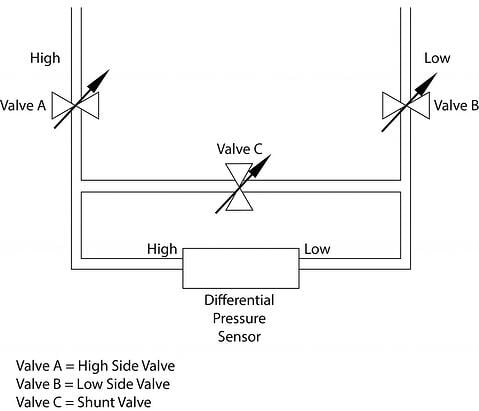Low Pressure Measurement
Low pressure measurements are required in various applications such as air flow, static duct and clean room pressures in heating, ventilating and air conditioning (HVAC) and energy management systems. Other applications include use in medical instrumentation, environmental pollution control, boiler combustion efficiency and a wide variety of research and development requirements. While this discussion will center mainly on air flows and pressures, the same principles also apply to liquids. As there are both pressure transducers (voltage output proportional to applied pressure) and pressure transmitters (current output proportional to applied pressure,) we will refer to each as pressure sensors in this application note.
Low pressure ranges are typically from 0.1 in H2O (.004 psi) Full Scale up to 25 in H2O (.903 psi) Full Scale. The pressure sensors used to make these measurements are very sensitive and overpressure can adversely affect accuracy or, in extreme cases, damage the units.
Pressure Cautions:
Low differential pressure measurements can be made with high line pressure, although, be sure that the line pressure does not exceed the maximum pressure rating of the device. Pressure relief valves with adequate venting capacity should be used in any system if the supply is capable of delivering the air, gas or fluid at pressure greater than the capacity of the pressure sensor.
Installation Precautions:
For differential pressure measurements at high line pressure, it is recommended that the pressure sensor be installed with a valve in each line, plus a shunt valve across the high and low (reference) pressure ports as shown below.

This is especially helpful for a liquid measuring application. Valve C should be open and Valves A and B closed whenever the system is first being wetted or pressurized. Valves A and B should then be opened slowly to avoid hammering. Valve C can then be closed and the system is operating.
When the differential pressure sensor is to be removed, Valve C must be opened first, then Valves A and B can be closed. Many types of pressure sensors are both mounting position and vibration sensitive. Be sure to follow the manufacturer's advice on this as it can affect the accuracy of your pressure measurement.
Temperature Cautions:
Temperature variations in both the ambient conditions and the media (liquid or gas) can affect the accuracy of the pressure sensors output signal. Be sure to check the operating temperature range and thermal error specification of the pressure sensor to determine suitability for the application.
Compatibility:
Media compatibility with the pressure sensor must be insured to prevent eventual failure of the pressure sensor and/or contamination of the media itself. Most manufacturers list the materials of construction that will come in contact with the media, and suggest uses they are suited for.


